I got a behind-the-scenes tour of Kleinfeld from 'Say Yes to the Dress,' and I was just as impressed by the stock room as I was the floor

- I took a behind-the-scenes tour of Kleinfeld, the iconic bridal store from "Say Yes to the Dress."
- The main floor where brides try on gowns was gorgeous, but the alterations floor impressed me more.
I'm not a bride, but I am a wedding reporter.

I spend my days interviewing couples about their weddings, analyzing engagement ring trends, and looking at wedding gowns.
I also write about "Say Yes to the Dress," and I recently connected with Marissa Rubinetti, the executive vice president and chief operating officer of Kleinfeld where the show takes place, about a line of lab-grown engagement rings the store made in collaboration with Zales.
After our talk, Rubinetti invited me to come to Kleinfeld for a tour, and as a longtime "Say Yes to the Dress" fan, I couldn't say no.
I arrived at Kleinfeld on a blustery Friday morning, crossing paths with excited brides-to-be as I entered.
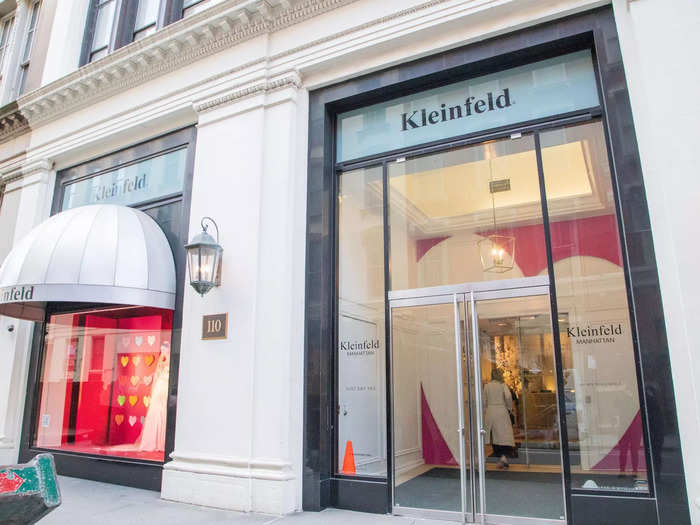
Although I've lived in New York for years, I somehow never stumbled across Kleinfeld in person.
It stood out on the street, both because of the dresses displayed in the window and because of the brides I saw stopping to snap selfies with the iconic Kleinfeld logo.
From the outside, it felt like a cross between a store and a tourist destination, and my interest was piqued as I opened the double doors to the famed boutique.
A glossy reception area greeted me when I walked inside Kleinfeld for the first time.
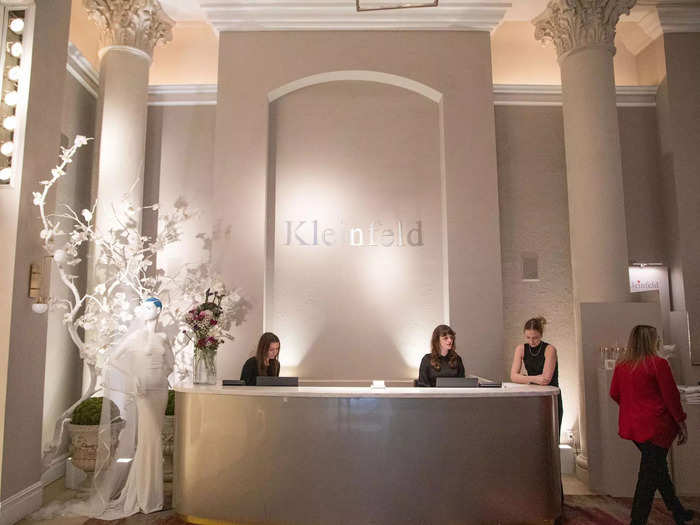
The front desk would be familiar to any "Say Yes to the Dress" fan, as it's often featured on the show.
The area was bustling when I arrived. Phones rang repeatedly, multiple groups checked in as I watched, and consultants fluttered by on their way to appointments.
The lobby was full of brides and their loved ones waiting to find their dream dresses.
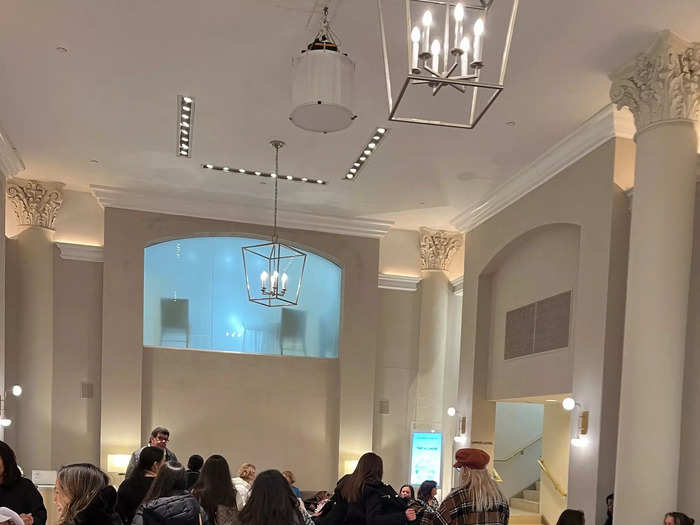
The area was packed, and I wondered if the lobby was full throughout the day.
But Rubinetti explained to me that the 11 a.m. appointments were about to start when I arrived, so all of the brides that would soon be on the floor were congregating in the lobby as they waited for their consultants.
There were five brides, and it seemed like each of them had at least two people with them to help find their gown. The room buzzed with their energy as I waited for my tour to start.
The main floor was spacious and every bit as exciting as it seemed on TV.
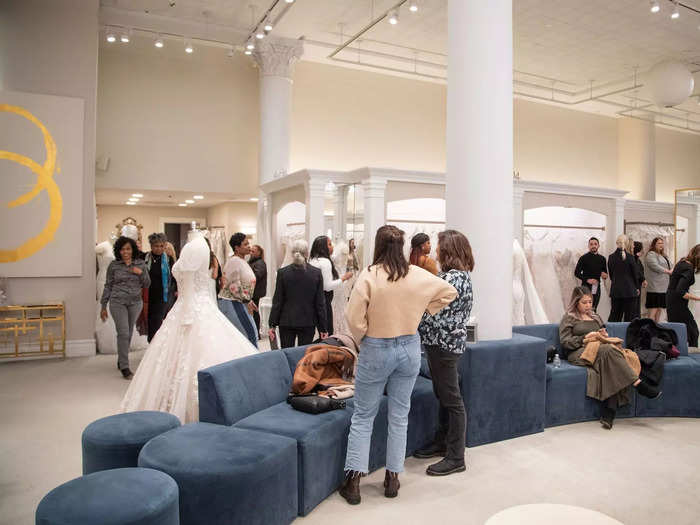
The room was oriented around pedestals and mirrors set up in the center of the space, where brides stood to look at themselves in gowns.
"Every consultant is paired up with a pedestal," Rubinetti told me as we walked the floor, explaining that each consultant worked with all of their brides for that day at the same pedestal.
Circular, blue couches encased the pedestals and mirrors, providing brides' entourages with places to sit and separating it from the aisle spaces where brides and consultants walked.
I felt like I had stepped into an episode of "Say Yes to the Dress" as I took in the space, watching as brides were escorted to dressing rooms, their guests settled into the couches, and consultants grabbed gown after gown from the racks lining the exterior of the room.
My eyes were immediately drawn to the dresses scattered throughout the space.

There were gowns all over the store, hanging on racks built into the walls and draping mannequins.
Rubinetti shared that the dresses that sit on the floor rotate, particularly if there's a trunk show highlighting one designer taking place at the store.
There's also an entire area of the store dedicated to the designer Pnina Tornai's gowns.
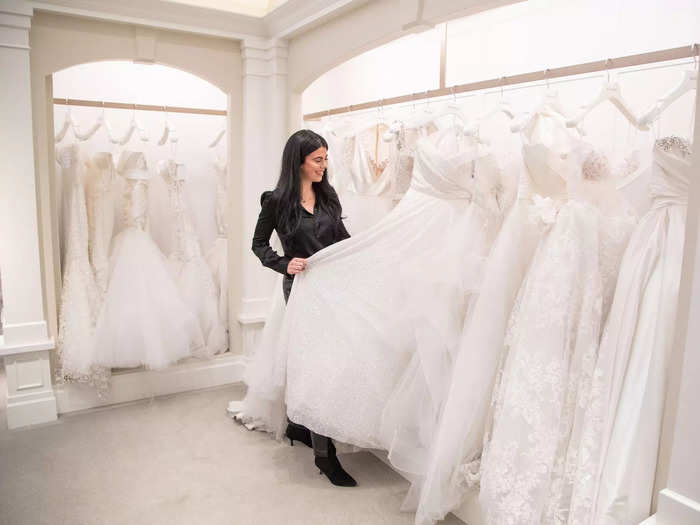
"The most important designer that we have here at Kleinfeld is Pnina, and she actually has her own boutique," Rubinetti said. Pnina Tornai has an exclusive relationship with Kleinfeld, so brides can't buy her gowns anywhere else.
The Pnina Tornai area of Kleinfeld has a separate room full of the designer's couture dresses, as well as two long racks built into cubbies in the wall surrounding the room with gowns from her other lines.
"When Pnina is working in here with our special brides, she does custom work for the bride or something like that," Rubinetti said of the room. "They'll sit at that table and they have a very intimate, private meeting."
Ally McGown, Tornai's boutique manager at Kleinfeld, gave Insider a look at some of the Pnina Tornai gowns available for brides to try on at the store.
Alongside the dresses, there's a jewelry display on Kleinfeld's main floor that sits on built-in shelves.
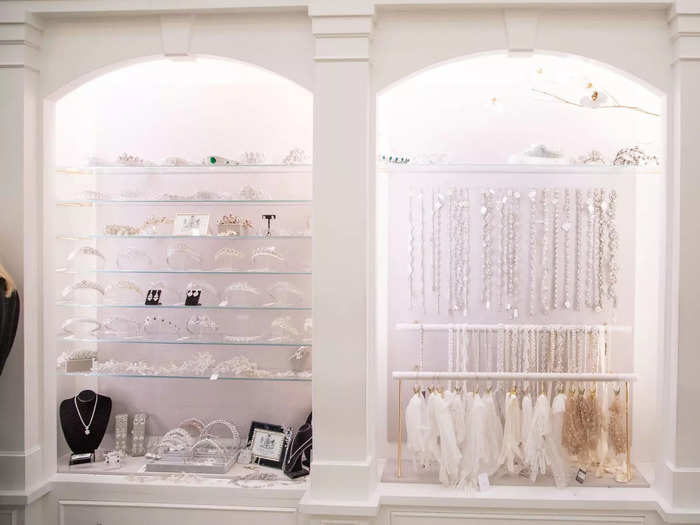
The area featured belts, tiaras, earrings, necklaces, and any other accessory a bride may need on her wedding day. Kleinfeld keeps its high-end accessories on the main floor, according to Rubinetti.
Rubinetti said adding accessories to a look can help a bride make a final decision on a gown.
"When the bride starts to find what she's looking for, maybe there's a dress that's a high contender, they really want to make sure that she accessorizes properly," Rubinetti said. "It's good to have the accessories up here so the consultants can say, 'Oh, do you want to add a belt? Do you want to try headpieces?'"
After we checked out the floor, my tour guide gave me a peek into the veil room.
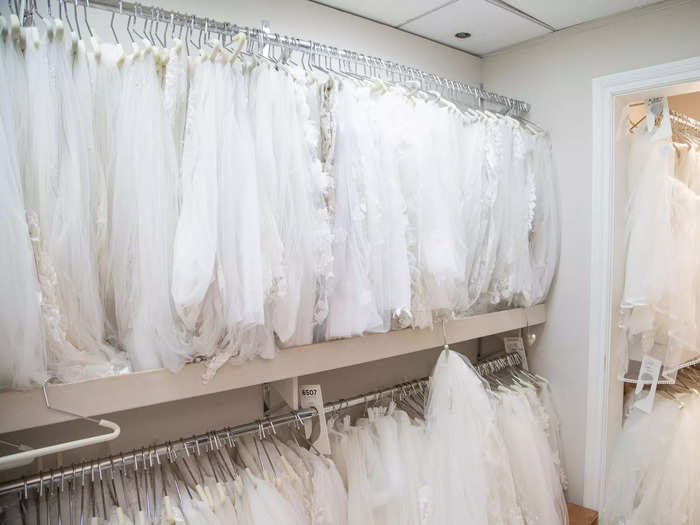
I was delighted when I walked into the room off the main floor that housed racks of veils.
I knew Kleinfeld had a variety of veils available from watching "Say Yes to the Dress," but a thrill went through me as I saw them lined up together.
A veil is often the final thing someone needs to see themselves as a bride in a wedding dress, and it was easy to imagine consultants carefully selecting the one that would complete a bride's look as I gazed at the racks.
The dressing rooms sit just past the floor.
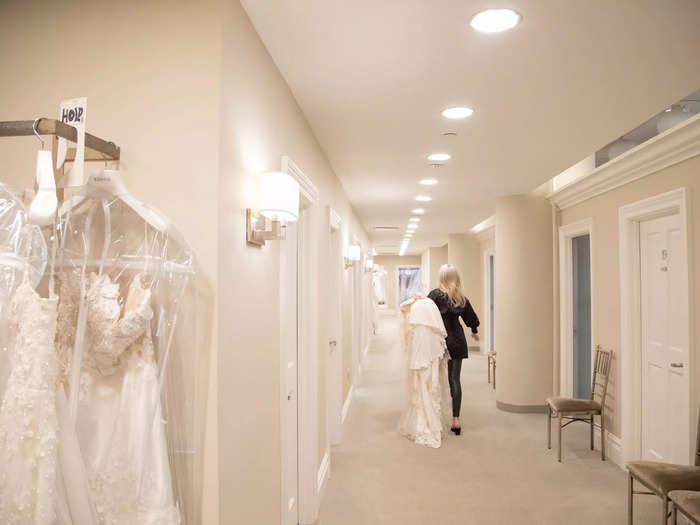
The dressing rooms sit to the left of the main floor behind a long wall. Two openings at each end of the hallway make it easy for clients and consultants to walk in and out.
I immediately noticed how much quieter it was as we walked down the hallway, which surprised me because it wasn't enclosed. The space felt calmer than the main floor, both because of the volume and because fewer people walked through it.
In addition to the standard fitting rooms, Kleinfeld also has a few VIP rooms for clients where an entire appointment can be conducted, as Rubinetti told Insider.
"If we have a bride that has more than three guests, we'll put them in a VIP room so that there's a little bit more space," she said. "They could get crowded on the floor."
The dressing rooms were more spacious than I expected on the inside.
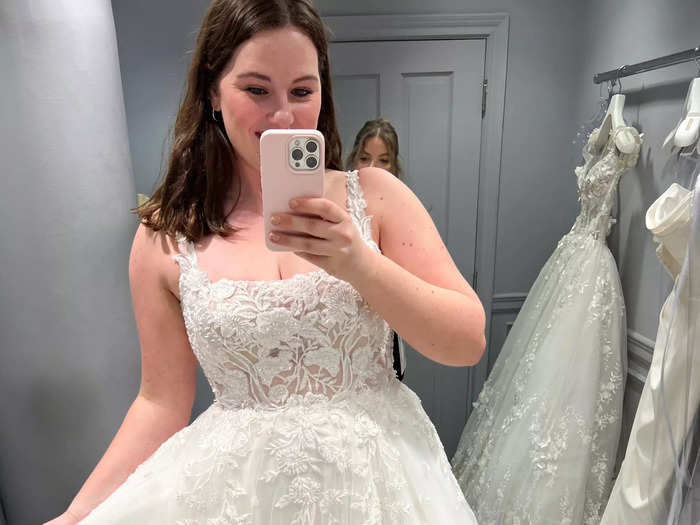
In addition to giving me a tour, Rubinetti arranged for me to have a mock appointment so I could feel what it was like to be a Kleinfeld bride (spoiler alert: it feels amazing).
Because I tried on dresses, I spent time in a fitting room with a consultant.
The room, which was painted a calming shade of blue, was even quieter than the hallway, which allowed me to have an intimate conversation with my consultant about what I wanted out of a dress. It had two chairs, a small desk for the consultant, and long racks where dresses could be hung.
There was also plenty of room for the dresses with full skirts I tried on, ensuring the gowns didn't wrinkle.
I was looking forward to seeing the stock room almost as much as I was the floor.
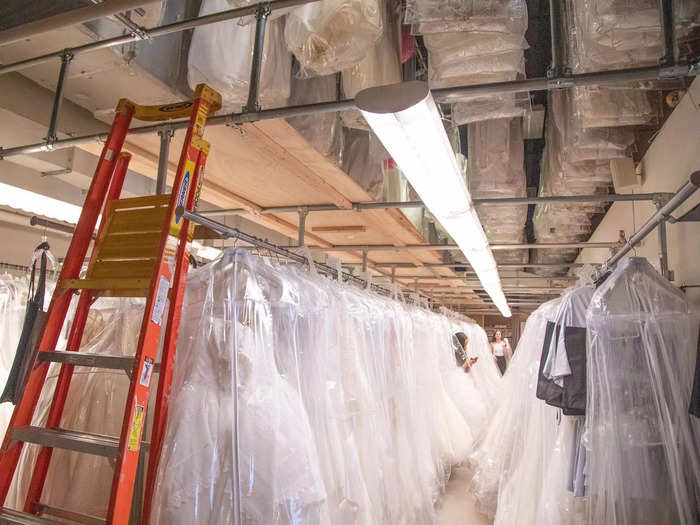
After checking out the fitting rooms, we headed to the stock room, which was being renovated at the time of my visit.
I had seen bridal consultants like Randy Fenoli find dream gowns for brides in the stock room countless times when watching "Say Yes to the Dress," and it didn't disappoint in person.
The room looked like a sea of white, as it houses all the dresses in the Kleinfeld store that aren't on the floor.
It seemed impossible that the consultants would be able to remember where everything was.
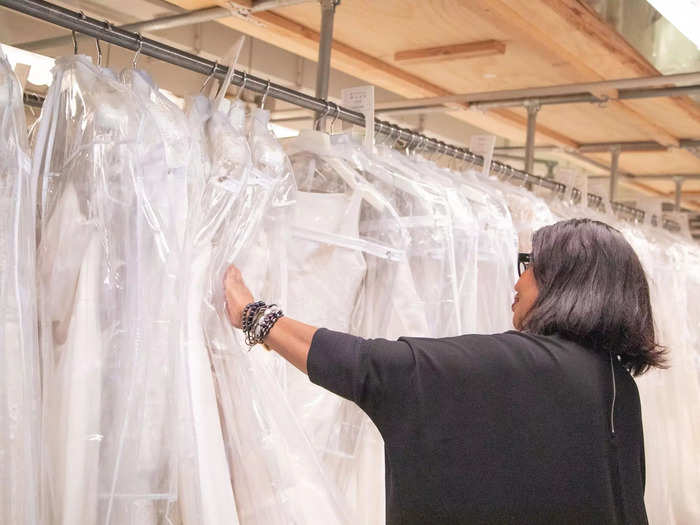
As I wandered through the stock room, I couldn't even begin to imagine how consultants found dresses each day. But the room is actually meticulously organized.
"It's organized by silhouette, and it's organized within silhouette by vendor," Rubinetti explained.
She also said the consultants spend time studying the gowns in the store, as well as trying them on in their free time to ensure they understand the dresses.
"The successful consultants are the ones that know every single dress," Rubinetti said. "The newer consultants take a longer time to get acclimated, but once the consultants know everything that's in the store, they have a better chance of serving the bride."
I was also surprised to see there were gowns hanging from the ceiling in the stock room.
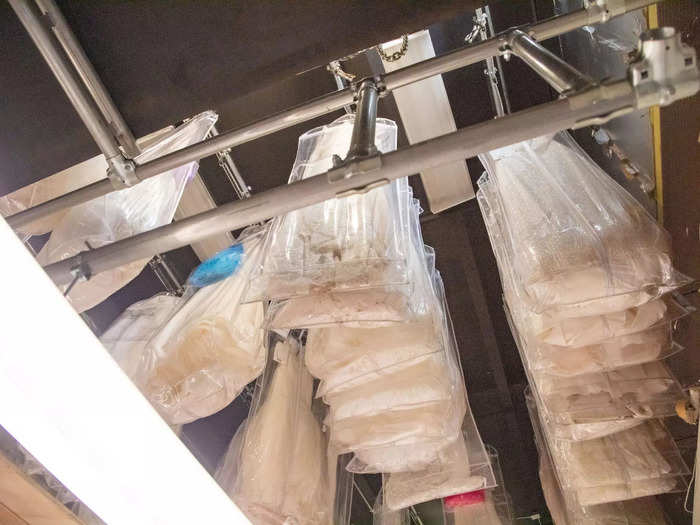
I had expected to see racks of dresses set up in the stock room, but I was surprised to see gowns hanging from the ceiling from a contraption called the RailX.
Unlike the dresses on the floor, the gowns above me had been purchased by brides, as Rubinetti told Insider. The floating racks are Kleinfeld's equivalent of a filing system for brides who haven't picked up their dresses yet.
"Sometimes the entire ceiling looks completely full," Rubinetti said.
The filing system is controlled from a different room Rubinetti refers to as the receiving room.
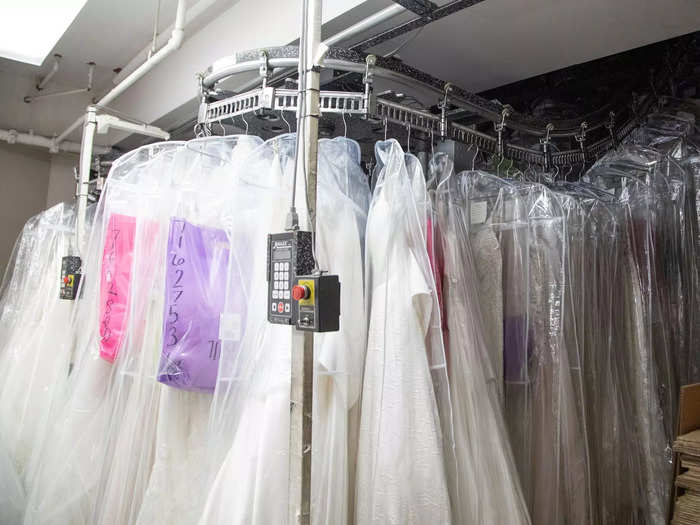
Each of the dresses is assigned a number, which can be accessed from a computer.
Kleinfeld staff can then enter the number of the dress on the remote attached to the RailX, and the dress will flow down so a staff member can grab it, similar to how a dry cleaner finds items for its customers.
All of the dresses at Kleinfeld come in and out of the receiving room.
The entire bottom floor of Kleinfeld is dedicated to alterations.
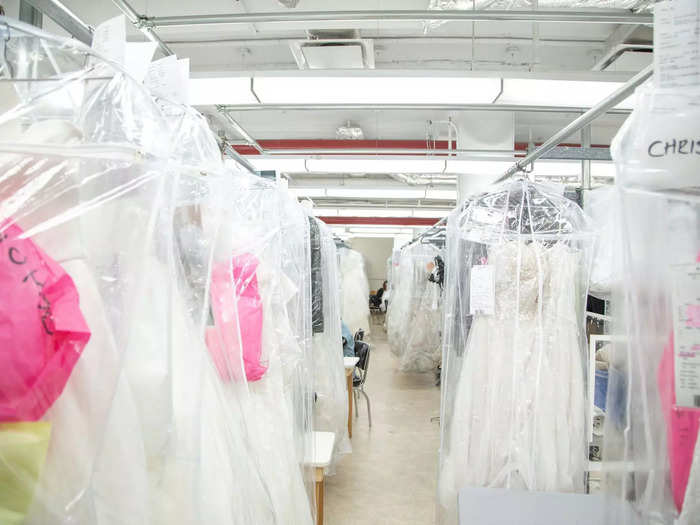
The alterations floor is huge, and there were gowns in almost every direction I turned.
Rubinetti told Insider that the alterations department used to cost Kleinfeld money, but under the leadership of Tina Zimmerman, Kleinfeld's current director of alterations, it's become a booming business for the company.
Unlike the glossy main floor at Kleinfeld, the alterations floor looked more like a warehouse. It was also quiet compared to the upper level, even though there were over a dozen employees working on gowns.
The first step of the alterations process at Kleinfeld is quality control.
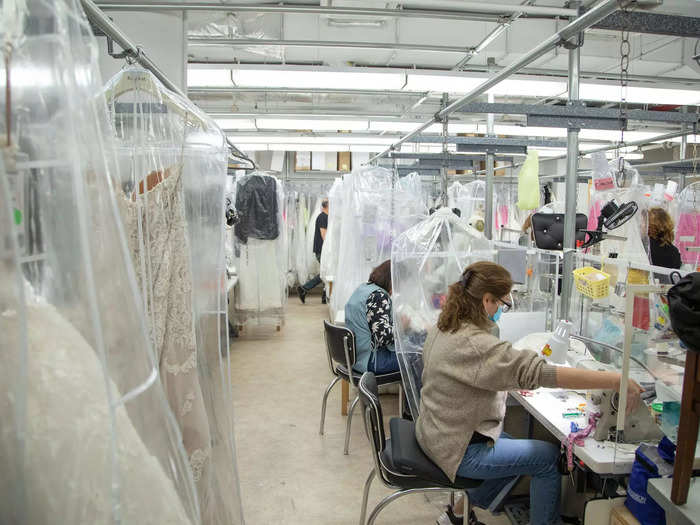
During quality control, a seamstress compares a gown to its photo, examining it for any errors before the bride sees it.
"These women are trained so specifically to see there is a thread loose or there's a drag line in this or this bead is loose or this color looks wrong or there's a zipper that's not functional, whatever it is," Rubinetti said. "They do a full QC process to make sure that it is pristine and in perfect condition so that when the bride gets it, there are no issues."
The alterations fitting rooms were different from the rooms upstairs.
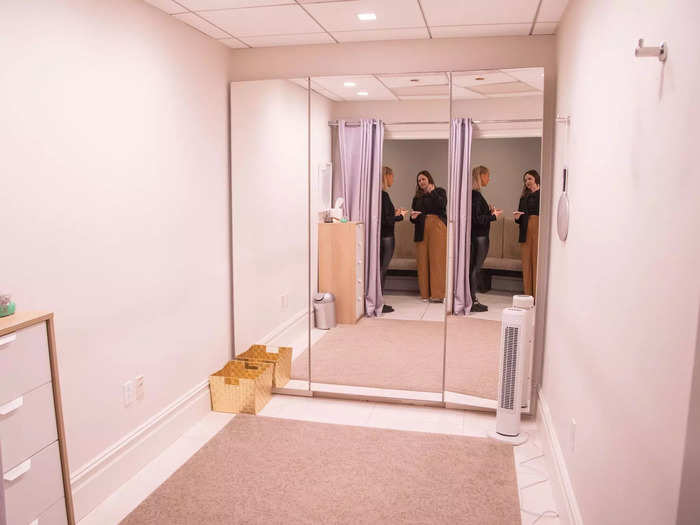
Unlike the rooms upstairs, the fitting rooms downstairs are closed with curtains instead of doors, and there are no chairs in the rooms themselves. The fitting rooms also seemed a bit bigger than the dressing rooms upstairs, and one entire wall was made of mirrors.
The fitting rooms downstairs are highly controlled environments, because brides wear their real wedding dresses when they're in them.
Rubinetti said fitters actually remove their shoes when they're in the fitting rooms with brides.
The fitter then makes adjustments to the dress per the bride's instructions.
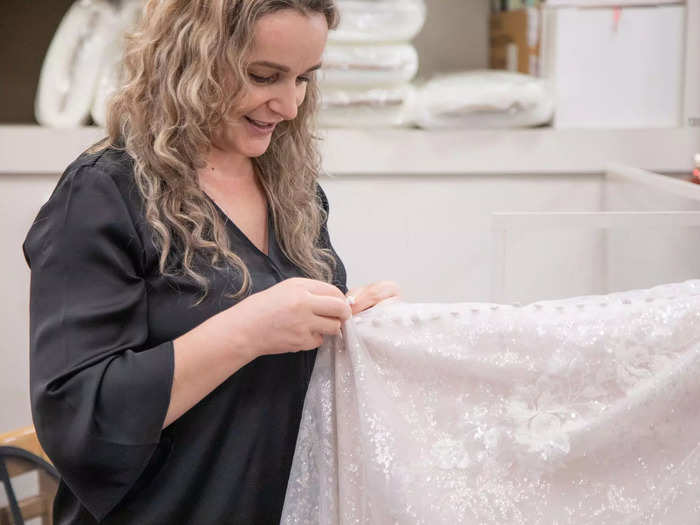
Kleinfeld brides have a series of appointments to ensure their dresses are in perfect condition for their wedding days, as Rubinetti told Insider.
She went on to say that fitters check alterations multiple times before returning gowns to brides.
During my visit, I passed by a fitter making adjustments to the buttons on a dress, examining an error in the gown I would never even have noticed was there.
There are different sections of the alterations floor dedicated to different types of alterations.

The seamstresses at Kleinfeld have different specialties, such as lace or hemming, and the floor is organized around their expertise. There's even an entire room dedicated to hand beading.
I was surprised to see how much dresses changed on the alterations floor. I watched seamstresses completely deconstruct the bodices of gowns to create the look a bride wanted.
The work looked incredibly involved, and I assumed it would take months to complete those alterations. But Rubinetti said the timeline is actually much shorter.
"We could do rush alterations in three days for a fee," she told Insider. "But for the most part, over a month, you probably have three separate fittings."
There was also a space dedicated to preparing gowns to be sent home with brides.
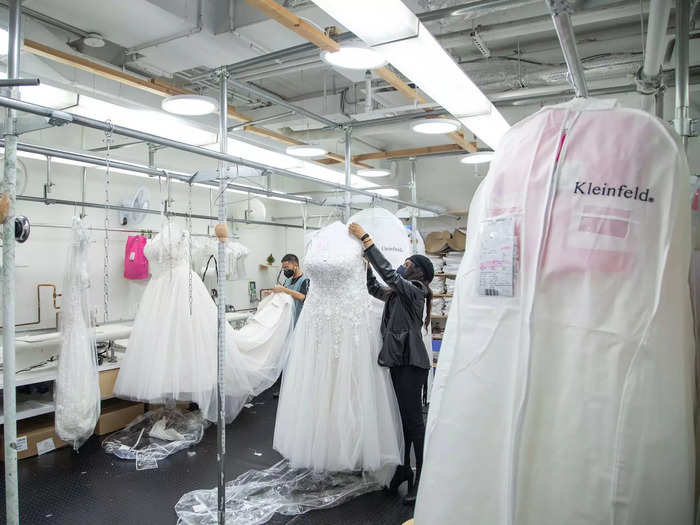
Kleinfeld staff refers to the back of the alterations floor as the pressing area, as it's where gowns are prepped to be sent home with brides for their weddings.
Rubinetti said it takes upwards of two to three hours to prepare a dress, in part because the gowns are stuffed with tissue to ensure they keep their shape for the wedding day.
"Sometimes we have a bride come in and she's like, 'I want to try my dress on,' and we're like, 'Please don't, because it just took us three hours to prep the dress,'" she said.
There was also a more extensive shopping area of Kleinfeld on the bottom floor.
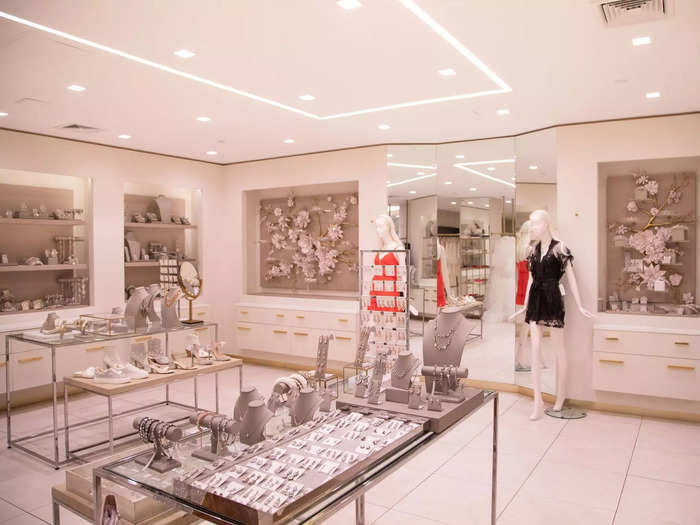
Kleinfeld's lounge on the bottom floor serves as the reception area for fittings, but it's also an area for brides and their families to shop.
I saw a few pieces of jewelry on the main floor of Kleinfeld, but there was a more extensive collection in the lounge, as well as lingerie, wedding-themed garments, and Kleinfeld merchandise. Rubinetti said brides who travel to Kleinfeld from other states are often drawn to the branded pieces.
"We've been working on introducing some new product categories to the mix because it's fun and brides love this kind of stuff," Rubinetti told Insider.
Kleinfeld felt every bit as magical as I hoped it would.
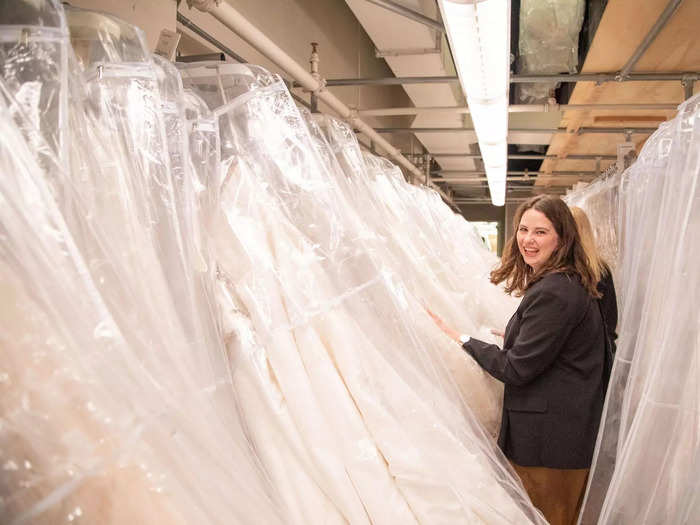
I've loved watching "Say Yes to the Dress" for years, but as I became a wedding reporter and heard how stressful shopping for a wedding dress can be for brides, I became skeptical that Kleinfeld could actually be as fun and welcoming as it seemed on the TLC series.
But after spending a day there, I really did feel the magic brides talk about when they find the gown of their dreams. The energy of the consultants was infectious, and the floor broke out in cheers as brides found their dresses.
Although being at Kleinfeld in person felt different than watching it on the show, it also felt strangely familiar. People repeatedly told me the store doesn't change at all when the TLC crew comes in to film, and I saw for myself that consultants had the same conversations I see on the show when the cameras are nowhere to be found.
Spaces like the alterations floor and stock room also drove home how much work the Kleinfeld staff puts in to ensure brides have the best experience possible at the store, even if they'll never be filmed.
After spending a day there, I can say Kleinfeld really does live up to the hype, which isn't something most reality TV sets can boast about.
Popular Right Now
Advertisement